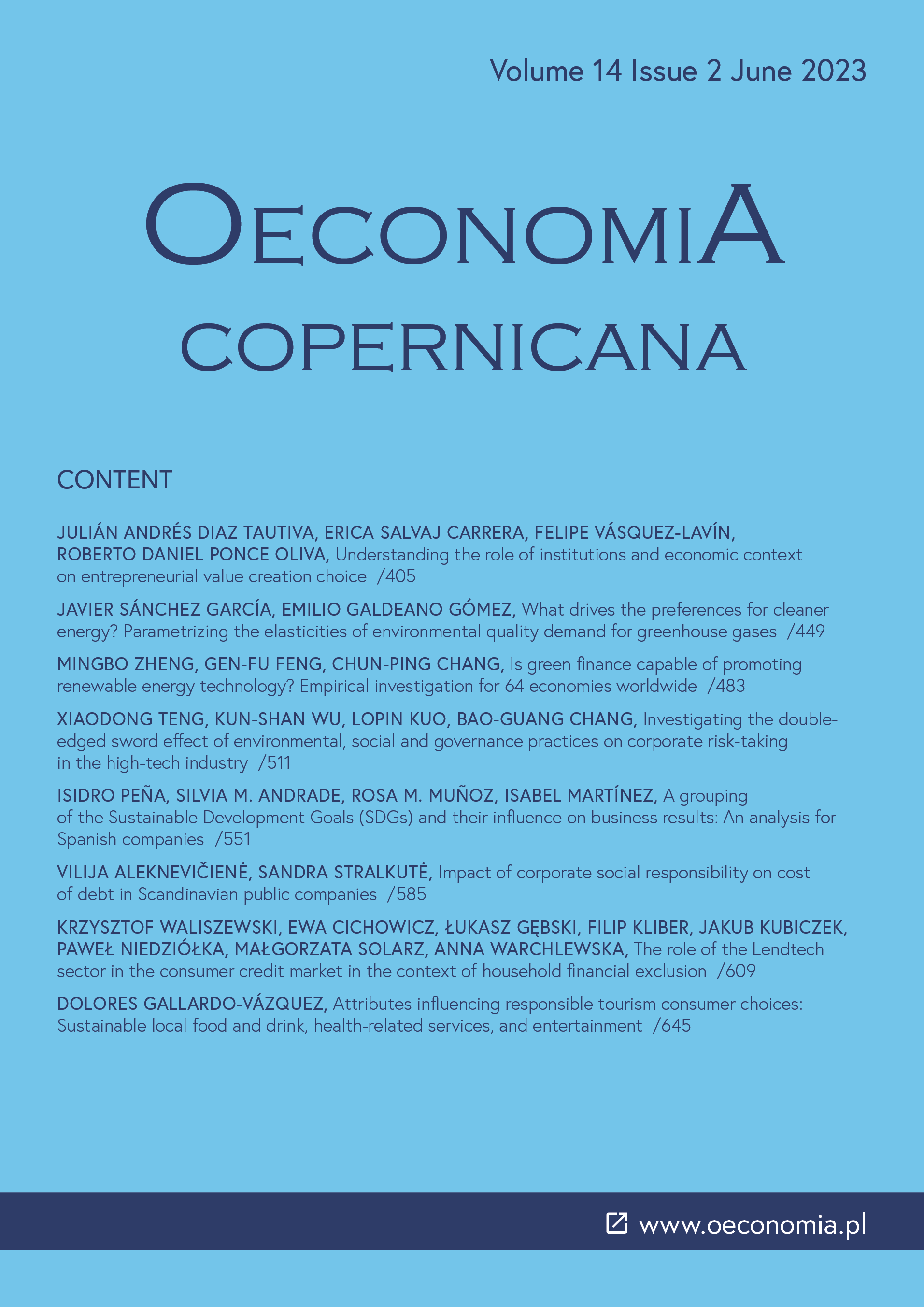What drives the preferences for cleaner energy? Parametrizing the elasticities of environmental quality demand for greenhouse gases
DOI:
https://doi.org/10.24136/oc.2023.012Keywords:
cleaner energy, environmental demand elasticity, business enterprises R+D, exposure to air pollutionAbstract
Research background: The heterogeneity in the factors that affect demand for environmental quality implicates a diverse set of policies and actions aimed at achieving cleaner production to address the challenges posed by pollution and damage to the natural environment. Even though this topic has been widely addressed, mainly from the traditional perspective of the Environmental Kuznets Curves hypothesis (EKC), it has been assumed that the environment is a luxury good with an income elasticity greater than unity. However, it has recently been recognized that the relationship between income and demand for cleaner energy may be more complex and that further inquiry may be needed for a better understanding.
Purpose of the article: This research work, employing a panel of European countries, offers direct explicit parameters for the elasticity of income-environmental quality demand for Greenhouse Gases (GHG), as well as its relationship with other important factors. It provides quantitative novel insights into the complex relationship between income and the preferences for cleaner energy.
Methods: A hierarchical regression equations approach is used to analyze the evolution of the elasticity of income-environmental quality demand with the inclusion of further co-variates that are relevant for the preferences side of the EKC, such as consumption, R+D investment and BERD (Business Enterprise Research and Development). The data for the empirical study comes from a panel of 16 European countries for the period from 2010 to 2020.
Findings & value added: The results show robust evidence that the elasticity of environmental quality demand, which although positive and significant, does not exceed one. To obtain an elasticity above unity, two more variables are needed, namely the R+D expenditure of business enterprises and the exposure of citizens to air pollution. These two factors have a similar or even higher effect on the preferences of agents for cleaner energy, which also means that the preferences of the citizens are endogenous to technological development. At the theoretical level, this work shows that the technological and preferences arguments are not substitute explanations of the EKC, but that technological development exerts a positive effect on the preferences of inhabitants, whose demand for environmental quality is heavily conditioned by their capabilities to see pollution, even more than by their income level. This also means that public policies directed to improve environmental awareness should be directed first towards those regions where the exposure of the citizens to pollution is lower.
Downloads
References
Álvarez-Herranz, A., Balsalobre-Lorente, D., Shahbaz, M., & Cantos, J. M. (2017). Energy innovation and renewable energy consumption in the correction of air pollution levels. Energy Policy, 105, 386–397. doi: 10.1016/j.enpol.2017.03.009.
DOI: https://doi.org/10.1016/j.enpol.2017.03.009
View in Google Scholar
Andreoni, J., & Levinson, A. (2001). The simple analytics of the environmental Kuznets curve. Journal of Public Economics, 80(2), 269–286. doi: 10.1016/S0047-2727(0 0)00110-9.
DOI: https://doi.org/10.1016/S0047-2727(00)00110-9
View in Google Scholar
Arrow, K., Bolin, B., Costanza, R., Dasgupta, P., Folke, C., Holling, C. S., Jansson, B.-O., Levin, S., Mäler, K.-G., Perrings, C., & Pimentel, D. (1995). Economic growth, carrying capacity, and the environment. Ecological Economics, 15(2), 91–95. doi: 10.1016/0921-8009(95)00059-3.
DOI: https://doi.org/10.1016/0921-8009(95)00059-3
View in Google Scholar
Balsalobre-Lorente, D., & Álvarez-Herranz, A. (2016). Economic growth and energy regulation in the environmental Kuznets curve. Environmental Science and Pollution Research, 23, 16478–16494. doi: 10.1007/s11356-016-6773-3.
DOI: https://doi.org/10.1007/s11356-016-6773-3
View in Google Scholar
Barbier, E. B., Czajkowski, M., & Hanley, N. (2017). Is the income elasticity of the willingness to pay for pollution control constant? Environmental and Resource Economics, 68, 663–682. doi: 10.1017/S10640-016-0040-4.
DOI: https://doi.org/10.1007/s10640-016-0040-4
View in Google Scholar
Barrett, S., & Graddy, K. (2000). Freedom, growth, and the environment. Environment and Development Economics, 5(4), 433–456. doi: 10.1017/S1355770X 00000267.
DOI: https://doi.org/10.1017/S1355770X00000267
View in Google Scholar
Ben Jebli, M., Madaleno, M., Schneider, N., & Shahzad, U. (2022). What does the EKC theory leave behind? A state-of-the-art review and assessment of export diversification-augmented models. Environmental Monitoring and Assessment, 194(6), 1–35. doi: 10.1007/s10661-022-10037-4.
DOI: https://doi.org/10.1007/s10661-022-10037-4
View in Google Scholar
Bimonte, S. (2009). Growth and environmental quality: Testing the double convergence hypothesis. Ecological Economics, 68(8-9), 2406–2411. doi: 10.1016/j.ecole con.2009.03.020.
DOI: https://doi.org/10.1016/j.ecolecon.2009.03.020
View in Google Scholar
Blampied, N. (2021). Economic growth, environmental constraints and convergence. The declining growth premium for developing economies. Ecological Economics, 181, 106919. doi: 10.1016/j.ecolecon.2020.106919.
DOI: https://doi.org/10.1016/j.ecolecon.2020.106919
View in Google Scholar
Bo, S. (2011). A literature survey on environmental Kuznets curve. Energy Procedia, 5, 1322–1325. doi: 10.1016/j.egypro.2011.03.229.
DOI: https://doi.org/10.1016/j.egypro.2011.03.229
View in Google Scholar
Casu, B., & Girardone, C. (2010). Integration and efficiency convergence in EU banking markets. Omega, 38(5), 260–267.
DOI: https://doi.org/10.1016/j.omega.2009.08.004
View in Google Scholar
Copeland, B., & Taylor, M. S. (2004). Trade, growth, and the environment. Journal of Economic Literature, 42, 7–71. doi: 10.1257/002205104773558047.
DOI: https://doi.org/10.1257/.42.1.7
View in Google Scholar
Crespo Cuaresma, J., Ritzberger-Grünwald, D., & Silgoner, M. A. (2008). Growth, convergence and EU membership. Applied Economics, 40(5), 643–656. doi: 10.1080 /00036840600749524.
DOI: https://doi.org/10.1080/00036840600749524
View in Google Scholar
Dinda, S. (2004). Environmental Kuznets curve hypothesis: A survey. Ecological Economics, 49(4), 431–455. doi: 10.1016/j.ecolecon.2004.02.011.
DOI: https://doi.org/10.1016/j.ecolecon.2004.02.011
View in Google Scholar
Dkhili, H. (2022). Investigating the theory of environmental Kuznets curve (EKC) in mena countries. Journal of the Knowledge Economy. Advance online publication. doi: 10.1007/s13132-022-00976-1.
DOI: https://doi.org/10.1007/s13132-022-00976-1
View in Google Scholar
Dutta, A., Bouri, E., Rothovius, T., & Uddin, G. S. (2023). Climate risk and green investments: New evidence. Energy, 265, 126376. doi: 10.1016/j.energy.2022.12 6376.
DOI: https://doi.org/10.1016/j.energy.2022.126376
View in Google Scholar
Ekins, P., & Speck, S. (2000). Proposals of environmental fiscal reforms and the obstacles to their implementation. Journal of Environmental Policy & Planning, 2(2), 93–114. doi: 10.1080/714038548.
DOI: https://doi.org/10.1080/714038548
View in Google Scholar
Expósito, A., Pablo-Romero, M., & Sánchez-Braza, A. (2019). Testing EKC for urban water use: Empirical evidence at river basin scale from the Guadalquivir river, Spain. Journal of Water Resources Planning and Management, 145(4), 04019005. doi: 10.1061/(ASCE)WR.1943-5452.0001052.
DOI: https://doi.org/10.1061/(ASCE)WR.1943-5452.0001052
View in Google Scholar
Figueroa, E., & Pasten, R. (2013). A tale of two elasticities: A general theoretical framework for the environmental Kuznets curve analysis. Economics Letters, 119(1), 85–88. doi: 10.1016/j.econlet.2013.01.019.
DOI: https://doi.org/10.1016/j.econlet.2013.01.019
View in Google Scholar
Figueroa, E., & Pasten, R. (2015). Beyond additive preferences: Economic behavior and the income pollution path. Resource and Energy Economics, 41, 91–102. doi: 10.1016/j.reseneeco.2015.04.004.
DOI: https://doi.org/10.1016/j.reseneeco.2015.04.004
View in Google Scholar
Fouquet, R. (2014). Power to the people: Energy in Europe over the last five centuries. Journal of Economic Literature, 52(4), 1160–1196. doi: 10.1257/jel.52.4.1160.
DOI: https://doi.org/10.1257/jel.52.4.1160
View in Google Scholar
Frodyma, K., Papiez, M., & Smiech, S. (2022). Revisiting the environmental Kuznets curve in the European Union countries. Energy, 241, 122899. doi: 10.1016/j.ener gy.2021.122899.
DOI: https://doi.org/10.1016/j.energy.2021.122899
View in Google Scholar
Grossman, G. M., & Krueger, A. B. (1995). Economic growth and the environment. Quarterly Journal of Economics, 110(2), 353–377. doi: 10.2307/2118443.
DOI: https://doi.org/10.2307/2118443
View in Google Scholar
Gyamfi, B. A., Bein, M. A., Ozturk, I., & Bekun, F. V. (2020). The moderating role of employment in an environmental Kuznets curve framework revisited in G7 countries. Indonesian Journal of Sustainability Accounting and Management, 4(2), 241–248. doi: 10.28992/ijsam.v4i2.283.
DOI: https://doi.org/10.28992/ijsam.v4i2.283
View in Google Scholar
Hasan, M. B., Ali, M. S., Uddin, G. S., Al Mahi, M., Liu, Y., & Park, D. (2022). Is Bangladesh on the right path toward sustainable development? An empirical exploration of energy sources, economic growth, and CO2 discharges nexus. Resources Policy, 79, 103125. doi: 10.1080/714038548.
DOI: https://doi.org/10.1016/j.resourpol.2022.103125
View in Google Scholar
Hausman, J. A. (1978). Specification tests in econometrics. Econometrica: Journal of the Econometric Society, 46(6), 1251–1271. doi: 10.2307/1913827.
DOI: https://doi.org/10.2307/1913827
View in Google Scholar
Hipólito Leal, P., & Cardoso Marques, A. (2022). The evolution of the environmental Kuznets curve hypothesis assessment: A literature review under a critical analysis perspective. Heliyon, 8, e11521. doi: 10.1016/j.heliyon.2022.e11521.
DOI: https://doi.org/10.1016/j.heliyon.2022.e11521
View in Google Scholar
Hu, H., Paudel, K. P., & Tan, Y. (2022). Income, policy, and pollution. Environmental and Resource Economics, 81, 131–153. doi: 10.1007/s10640-021-00621-6.
DOI: https://doi.org/10.1007/s10640-021-00621-6
View in Google Scholar
Jeffords, C., & Thompson, A. (2019). The human rights foundations of an EKC with a minimum consumption requirement: Theory, implications, and quantitative findings. Letters in Spatial and Resource Sciences, 12(1), 41–49. doi: 10.1007/s12076-019-00225-1.
DOI: https://doi.org/10.1007/s12076-019-00225-1
View in Google Scholar
Kahn, M. E., Sun, W., & Zheng, S. (2022). Clean air as an experience good in urban china. Ecological Economics, 192, 107254. doi: 10.1016/j.ecolecon.2021.107254.
DOI: https://doi.org/10.1016/j.ecolecon.2021.107254
View in Google Scholar
Khanna, N., & Plassmann, F. (2004). The demand for environmental quality and the environmental Kuznets curve hypothesis. Ecological Economics, 51(3-4), 225–236. doi: 10.1016/j.ecolecon.2004.06.005.
DOI: https://doi.org/10.1016/j.ecolecon.2004.06.005
View in Google Scholar
Lantz, V., & Feng, Q. (2006). Assessing income, population, and technology impacts on CO2 emissions in Canada: Where’s the EKC? Ecological Economics, 57(2), 229–238. doi: 10.1016/j.ecolecon.2005.04.006.
DOI: https://doi.org/10.1016/j.ecolecon.2005.04.006
View in Google Scholar
Lawell, C.-Y. C. L., Paudel, K. P., & Pandit, M. (2018). One shape does not fit all: A nonparametric instrumental variable approach to estimating the income-pollution relationship at the global level. Water Resources and Economics, 21, 3–16. doi: 10.1016/j.wre.2018.01.001.
DOI: https://doi.org/10.1016/j.wre.2018.01.001
View in Google Scholar
Lekakis, J. N., & Kousis, M. (2001). Demand for and supply of environmental quality in the environmental Kuznets curve hypothesis. Applied Economics Letters, 8(3), 169–172. doi: 10.1080/13504850150504531.
DOI: https://doi.org/10.1080/13504850150504531
View in Google Scholar
Lewis, M. (2007). Stepwise versus hierarchical regression: Pros and cons. Online Submission.
View in Google Scholar
Lin, C.-Y. C., & Liscow, Z. D. (2013). Endogeneity in the environmental Kuznets curve: An instrumental variables approach. American Journal of Agricultural Economics, 95(2), 268–274. doi: 10.1093/ajae/aas050.
DOI: https://doi.org/10.1093/ajae/aas050
View in Google Scholar
Lindmark, M. (2002). An EKC-pattern in historical perspective: Carbon dioxide emissions, technology, fuel prices and growth in Sweden 1870–1997. Ecological Economics, 42(1-2), 333–347. doi: 10.1016/S0921-8009(02)00108-8.
DOI: https://doi.org/10.1016/S0921-8009(02)00108-8
View in Google Scholar
Liu, Y., Cheng, X., & Li, W. (2021). Agricultural chemicals and sustainable development: The agricultural environment Kuznets curve based on spatial panel model. Environmental Science and Pollution Research, 28(37), 51453–51470. doi: 10.1007/s11356-021-14294-7.
DOI: https://doi.org/10.1007/s11356-021-14294-7
View in Google Scholar
McConnell, K. E. (1997). Income and the demand for environmental quality. Environment and Development Economics, 2(4), 383–399. doi: 10.1017/S1355770X97 00020X.
DOI: https://doi.org/10.1017/S1355770X9700020X
View in Google Scholar
Ohler, A. M. (2015). Factors affecting the rise of renewable energy in the us: Concern over environmental quality or rising unemployment? Energy Journal, 36(2), 97–115. doi: 10.5547/01956574.36.2.5.
DOI: https://doi.org/10.5547/01956574.36.2.5
View in Google Scholar
Panayotou, T. (1997). Demystifying the environmental Kuznets curve: Turning a black box into a policy tool. Environment and Development Economics, 2(4), 465–484. doi: 10.1017/S1355770X97000259.
DOI: https://doi.org/10.1017/S1355770X97000259
View in Google Scholar
Pasten, R., & Figueroa, E. (2012). The environmental Kuznets curve: A survey of the theoretical literature. International Review of Environmental and Resource Economics, 6(3), 195–224. doi: 10.1561/101.00000051.
DOI: https://doi.org/10.1561/101.00000051
View in Google Scholar
Pata, U. K., & Samour, A. (2022). Do renewable and nuclear energy enhance environmental quality in France? A new EKC approach with the load capacity factor. Progress in Nuclear Energy, 149, 104249. doi: 10.1016/j.pnucene.2022.104249.
DOI: https://doi.org/10.1016/j.pnucene.2022.104249
View in Google Scholar
Plassmann, F., & Khanna, N. (2006). Preferences, technology, and the environment: Understanding the environmental Kuznets curve hypothesis. American Journal of Agricultural Economics, 88(3), 632–643. doi: 10.1111/j.1467-8276.2006.00884.x
DOI: https://doi.org/10.1111/j.1467-8276.2006.00884.x
View in Google Scholar
Roca, J. (2003). Do individual preferences explain the environmental Kuznets curve? Ecological Economics, 45(1), 3–10. doi: 10.1016/S0921-8009(02)00263-X.
DOI: https://doi.org/10.1016/S0921-8009(02)00263-X
View in Google Scholar
Rume, T., & Didar-Ul Islam, S. M. (2020). Environmental effects of COVID-19 pandemic and potential strategies of sustainability. Heliyon, 6(9), e04965. doi: 10.101 6/j.heliyon.2020.e04965.
DOI: https://doi.org/10.1016/j.heliyon.2020.e04965
View in Google Scholar
Schönfelder, N., & Wagner, H. (2019). Institutional convergence in Europe. Economics, 13(1), 1–23. doi: 10.5018/economics-ejournal.ja.2019-3.
DOI: https://doi.org/10.5018/economics-ejournal.ja.2019-3
View in Google Scholar
Shafik, N., & Bandyopadhyay, S. (1992). Economic growth and environmental quality: Time-series and cross-country evidence (Vol. 904). World Bank Publications.
View in Google Scholar
Shafiullah, M., Papavassiliou, V., & Shahbaz, M. (2021). Is there and extended education-based environmental Kuznets curve? An analysis of U.S. States. Environmental and Resource Economics, 80, 795–819. doi: 10.1007/s10640-021-0061 0-9 .
DOI: https://doi.org/10.1007/s10640-021-00610-9
View in Google Scholar
Simionescu, M., Szeles, M. R., Gavurova, B., & Mentel, U. (2021). The impact of quality of governance, renewable energy and foreign direct investment on sustainable development in cee countries. Frontiers in Environmental Science, 425. 9,765927. doi: 10.3389/fenvs.2021.765927.
DOI: https://doi.org/10.3389/fenvs.2021.765927
View in Google Scholar
Stern, D. I. (2017). The environmental Kuznets curve after 25 years. Journal of Bioeconomics, 19, 7–28. doi: 10.1007/s10818-017-9243-1.
DOI: https://doi.org/10.1007/s10818-017-9243-1
View in Google Scholar
Tenaw, D., & Beyene, A. D. (2021). Environmental sustainability and economic development in Sub-saharan Africa: A modified EKC hypothesis. Renewable and Sustainable Energy Reviews, 143, 110897. doi: 10.1016/j.rser.2021.110897.
DOI: https://doi.org/10.1016/j.rser.2021.110897
View in Google Scholar
Thompson, A. (2012). Water abundance and an ekc for water pollution. Economics Letters, 117(2), 423–425. doi: 10.1016/j.econlet.2012.06.014.
DOI: https://doi.org/10.1016/j.econlet.2012.06.014
View in Google Scholar
Thompson, C. G., Kim, R. S., Aloe, A. M., & Becker, B. J. (2017). Extracting the variance inflation factor and other multicollinearity diagnostics from typical regression results. Basic and Applied Social Psychology, 39(2), 81–90. doi: 10.1080/0197 3533.2016.1277529.
DOI: https://doi.org/10.1080/01973533.2016.1277529
View in Google Scholar
Villanthenkodath, M. A., Gupta, M., Saini, S., & Sahoo, M. (2021). Impact of economic structure on the environmental Kuznets curve (EKC) hypothesis in India. Journal of Economic Structures, 10(1), 1–17. doi: 10.1186/s40008-021-00259-z.
DOI: https://doi.org/10.1186/s40008-021-00259-z
View in Google Scholar
Yang, Q., Huo, J., Saqib, N., & Mahmood, H. (2022). Modelling the effect of renewable energy and public-private partnership in testing EKC hypothesis: Evidence from methods moment of quantile regression. Renewable Energy, 192, 485–494. doi: 10.1016/j.renene.2022.03.123.
DOI: https://doi.org/10.1016/j.renene.2022.03.123
View in Google Scholar
Zhao, X., & Luo, D. (2017). Driving force of rising renewable energy in China: Environment, regulation and employment. Renewable and Sustainable Energy Reviews, 68, 48–56. doi: 10.1016/j.rser.2016.09.126.
DOI: https://doi.org/10.1016/j.rser.2016.09.126
View in Google Scholar
Zilio, M. I. (2012). Environmental Kuznets Curve: The validity of its fundaments in emergent countries. Cuadernos de Economía, 35(97), 43–54.
DOI: https://doi.org/10.1016/S0210-0266(12)70022-5
View in Google Scholar






